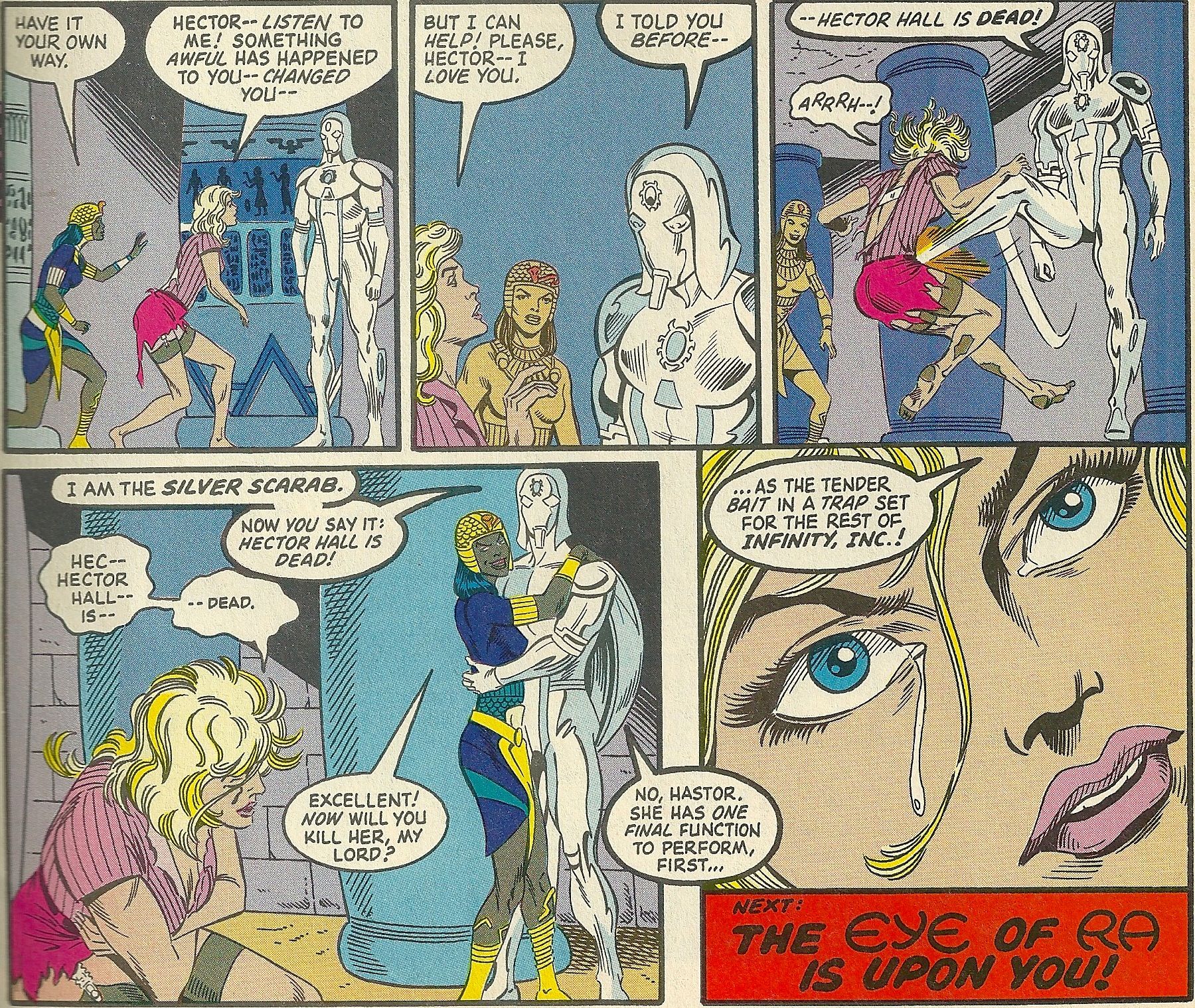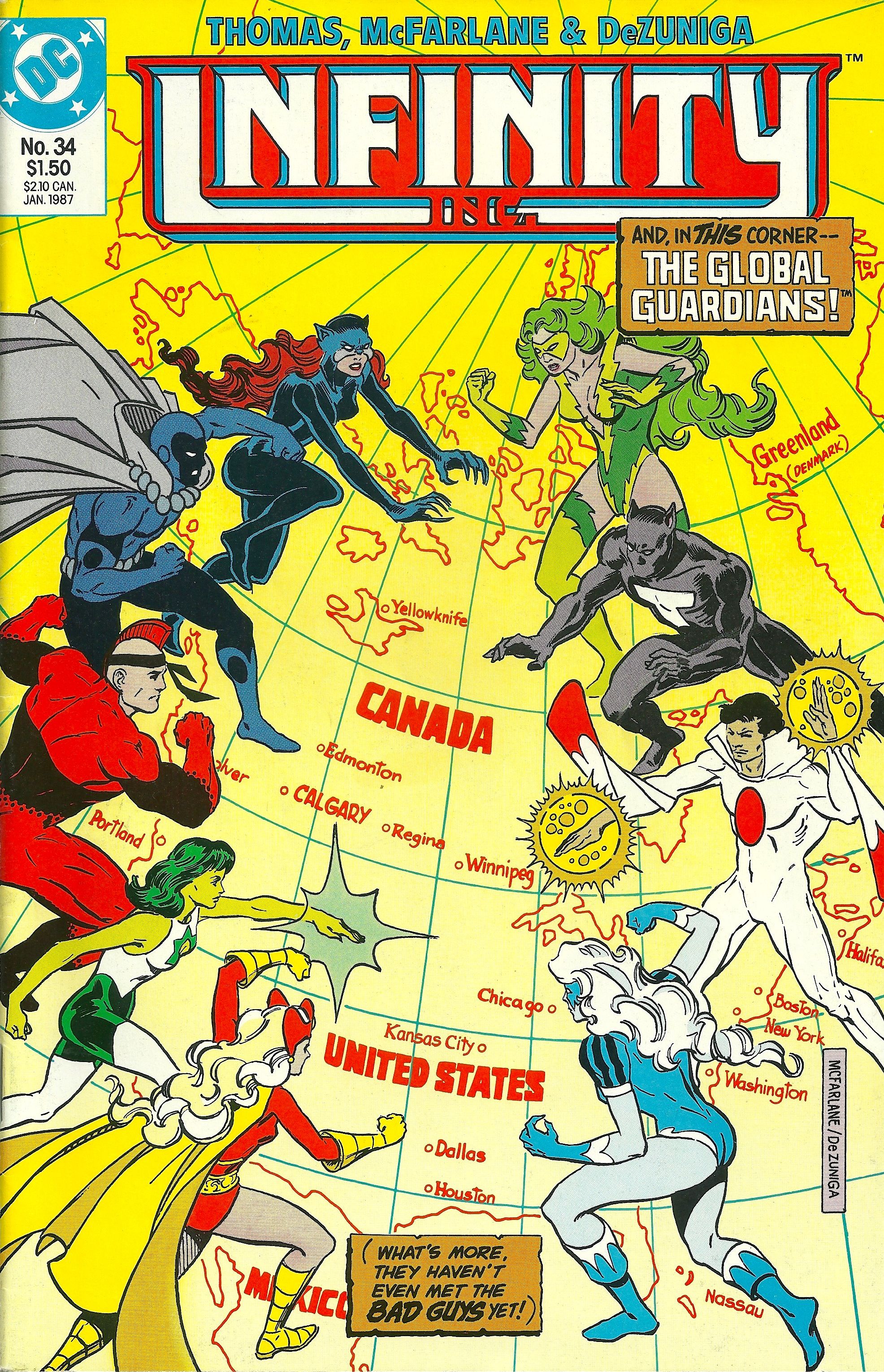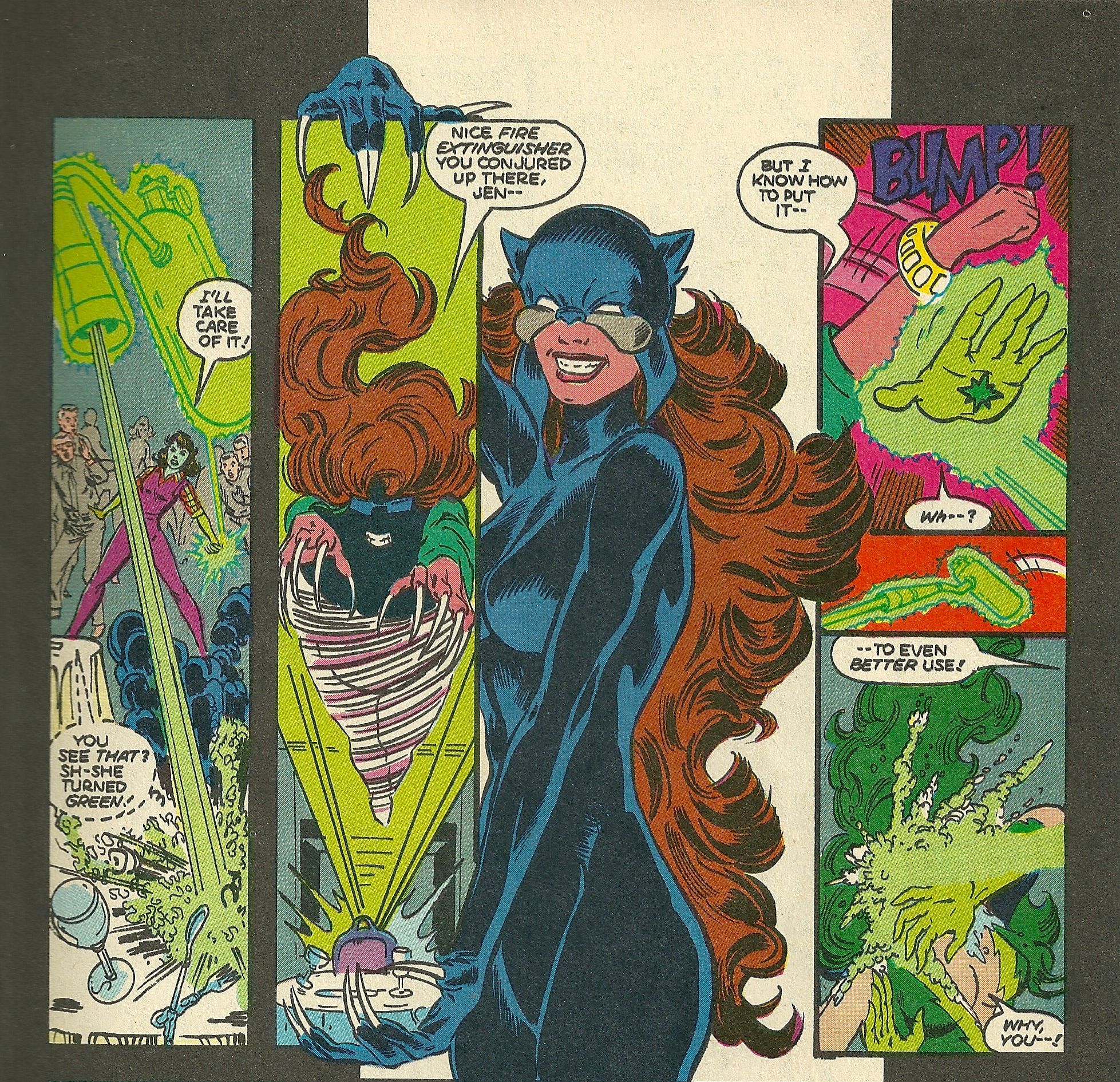A column in which Matt Derman (Comics Matter) reads & reviews comics from 1987, because that’s the year he was born. Click here for an archive of all the previous posts in the series.
Infinity Inc. #34-44 (DC) by Roy Thomas, Dann Thomas, Todd McFarlane (#34-37), Martin King (#38), Michael Bair (#39), Vince Argondezzi (#40-44), Tony DeZuniga (#34-42, 44), Pablo Marcos (#39), Danny Bulanadi (#40), Al Vey (#42), Rodin Rodriguez (#43), Alfredo Alcala (#43) Liz Bérubé (#34, 38, 41, 43-44), Carl Gafford (#35-37, 40), Anthony Tollin (#39), Shelley Eiber (#42), David C. Weiss (#34-39), Agustin Mas (#39-40), Jean Simek (#41-44)
It's a little hard to sum up my opinion on the 1987 issues of Infinity Inc., because it was an unsteady series at that time, varying in quality not only from issue to issue but often from scene to scene. It was more interested in the personal dramas of its cast than the flash and flair of superpowered action, yet the action sequences were more reliably entertaining than the more grounded character work. Then again, all the strongest moments center on the characters' emotional lives, but so do the weakest ones, with the fight scenes falling somewhere in between. This gives the comic a strange lack of identity; is it compelling teenage drama or lame teenage melodrama, a fun superhero adventure or a dull superhero business meeting? With 27 story pages per issue (on average...sometimes 26 or 28) Infinity Inc. has room to be all of those things and more, but it's never any one thing for long enough to get the reader fully, unwaveringly invested. This is frustrating to a degree, but also appropriate, because as a team Infinity, Inc. is a fairly disjointed, non-unified group. They have wildly different priorities and opinions on how to operate, and they pretty much never do anything as a full team, splintering instead into smaller units for each new mission/threat. So the book's somewhat chaotic voice fits nicely with the team's mismatched energy, and may even be an intentional aspect of the storytelling for that reason. Which is all well and good, but doesn't make it any easier to know precisely how I feel about these issues as a group.
There are certainly things to love in this comic. One of the biggest and best throughlines in this run is the story of Hector Hall/Silver Scarab becoming a villain, an event prophesied long ago and one that has tremendous significance for several members of the cast. Lyta Trevor/Fury is carrying Hec's baby, though he doesn't know it, so when he turns bad and suddenly abandons her, it obviously hits pretty hard. It also affects Albert Rothstein/Nuklon, who considers Hec a friend but also harbors a secret love for Lyta, and struggles with seeing her suffer over another man. Meanwhile, Norda/Northwind has been warned of Hec's impending change, and returns to their shared homeland of Feitheira to train himself for the battle to save the planet that he knows will be inevitable once Hec's transformation is complete. This all culminates in Lyta making one last attempt to win Hec back, and instead being brutally attacked and kidnapped by him and his new ally and lover, Hath-Set. Norda then returns to warn Infinity, Inc. of the immense danger their former friend now represents, and the team fights and ultimately kills the new, evil Silver Scarab, no longer identifying himself as Hector Hall now that he's fulfilled his villainous destiny.
It's a rather straightforward story on the surface of it: a prophecy of doom and death, a gang of heroes going up against an enemy far more powerful than they, the turmoil of friends having to fight friends. These are all familiar elements, even in combination with one another, but there are some nice details and emotional beats in Infinity Inc. that enhance the narrative and add to its impact. Norda is single-mindedly determined to defeat Hector, knowing himself to be the only person with the knowledge and skill to pull it off, yet at the same time he hates to have to be the one to bring down his old friend. Norda is therefore simultaneously the most and least enthusiastic of the good guys, never faltering but also never entirely confident in his actions. That translates into a new, more overbearing, short-tempered personality for Norda, a tough front he must keep up to get the job done, and the fresh attitude makes both him and the story more interesting. He's so forceful and decisive that the rest of the Infinitors get swept up in the momentum of Norda's zeal, keeping the story snappy and pushing the team to action at a much quicker rate than they're usually capable of.
Lyta adds the most to this arc, though, primarily through her profound suffering. When she finally finds Hector, which takes no small effort, he is already a full-on bad guy, permanently encased in his suit of ninth-metal armor and only responding to the name Silver Scarab. Well, actually, Lyta first finds the discarded husk of Hector's old body, and then meets the evil Silver Scarab version, so it's a one-two punch of pain, thinking he's dead and then immediately learning that, no, he's just evil now. The Scarab tells her repeatedly that Hector Hall is no more, and when she refuses to accept it and tries to fight back, he attacks her ruthlessly. One of the toughest scenes to read, but also one of the most effective, is when Scarab kicks Lyta in the stomach—he still doesn't know she's pregnant, but we do, making it all the harder to see her take that kind of blow—then forces her to say out loud that Hector Hall is dead. It's truly brutal, an understandable breaking point for Lyta and an intense experience all around.
Another part of what makes the Silver Scarab narrative so good is that it's the slowest-burning story here. The very first scene of Infinity Inc. #34 has Norda discovering that he's too late to prevent Hec's change, and the final battle with the Silver Scarab doesn't resolve until the end of issue #44. Along the way, we see Norda's return to Feitheira, Hec's break up with Lyta, the rest of the team learning about and reacting to Lyta's pregnancy (some more supportively than others), and then, of course, the actual fight to save the world. Roy and Dann Thomas stretch out the thread but don't ever drop it, always at least giving a nod to Lyta's pregnancy and/or Hector's elusiveness each issue until things come to a head. By the time this story becomes the focus, then, the stakes have been well built up and the suspense is palpable.
That's not always the Thomases' approach, though, and many other storylines have a jerkier rhythm and thus a more awkward development. Solomon Grundy's weird devotion to Jade after she frees him from a glacier crops up and disappears sporadically, most often treated like an insignificant, semi-humorous detail. But then issue #39 is almost entirely spent retelling Grundy's origin and then revisiting his entire life story, so there's a mixed message from the comic about how important we're supposed to think that character is. There's a super-boring plot about Jade and Obsidian taking partial ownership of a radio station with their stepmom that is discussed kind of frequently but never actually matters to anything else that happens. Along the same lines, there's an obnoxious amount of time spent talking about the business side of Infinity, Inc., like arguments about commercials and strangely tense yet utterly mundane team meetings. Conceptually, I guess it might be interesting to look at superheroism as a profession, and there have been well-done heroes for hire books before, but in Infinity Inc. that stuff always ends up being a slog to get through, and it's rarely if ever necessary for the bigger stories being told.
Then there are some more general stylistic flaws, particularly the often stiff and repetitive dialogue. In the tradition of "every issue could be someone's first," there's a lot of characters explaining their powers, stating out loud opinions we've heard many times before, and recapping past events that everyone in-story would already know. I do appreciate any efforts toward new reader friendliness, but in this case it goes too far too often, taking up space with needless and uninspired conversations about old topics or, worse, topics that hold no interest.
I don't mean to give the impression that the Silver Scarab plot is the single diamond in the rough that is the rest of the comic. There are some other tasty bits in there, too. Hourman kills a villain and has a crisis of conscience, seriously considering retirement from the superhero lifestyle until Dr. Midnight slowly but surely help him get his mojo back. Her care and concern for him is touching, genuine, and relatable, giving readers a clear path to empathize with Hourman even though his specific struggle isn't all that universal a problem (because not too many of us have taken the life of a supervillain before). Brainwave and Jade have a sweet, sincere-but-not-overly-serious romance that's often quite funny, a welcome source of humor and affection. Though his rhyming dialogue can be grating at times, Mr. Bones also does well is his comic relief role, a great foil for the more self-important Infinitors who need to be brought down a peg or two. Basically I just mean Skyman, I guess, but he's so stern all the time it feels like there's more than one stick in the mud hanging around, and Mr. Bones plays nicely off of that.
Even the artists are all ups and downs. There are four pencilers over the course of the eleven issues, and each of them shines in some places, but they all have their missteps, too. Todd McFarlane draws the first four issues, and kills it on the splash pages. There are a few really striking full- or half-page images: Hector and Hath-Set in bed together smirking wickedly at a shocked Norda, Solomon Grundy bursting through the ice, the introduction of Injustice, Unlimited. However, a handful of impressive large visuals doesn't quite make up for the cramped, crowded panels of the other pages. Especially when McFarlane randomly includes drawings of the characters that aren't even part of the story, essentially just portraits stuck in the middle of what should be a continuous narrative. The first time it happens, it looks like Wildcat is holding up a panel in which Wildcat is pouncing at somebody, so...yeah, that's confusing. I don't know if McFarlane just liked to include sketches for the sake of it, or if he planned his layouts so badly that there was sometimes extra space to fill, or what exactly was going on there, but at best it was a distraction and at worst it actually made the comic harder to read.
Martin King and Michael Bair draw one issue each, and they have similar highs and lows. King's issue opens with a stellar Nuklon dream sequence, a sexual fantasy about Lyta but treated with such reverence, tenderness, and surrealism by King that it comes across as innocently sweet rather than creepy or perverse. It's a great first two pages, but there's nothing else like it for the rest of the issue, which is not at all bad but not extraordinary either. Bair does some superbly trippy horror stuff for the first few pages of Solomon Grundy's origin tale, maybe my favorite art in the run, but then his issue quickly becomes more crowded and chaotic than anything McFarlane drew, and never opens up again. It's not hard to follow, it's just too tightly packed, each page a challenge to take in as a whole even if every panel is clear.
Vince Argondezzi pencils the last five issues, and is has the crispest, snappiest style. Sometimes he overloads on the number of panels, too, but he's better at walking the line between comfortably snug and overwhelmingly overstuffed. He also does the best, most exciting action, which may be in part because he gets the most action to draw, but right at the start of his first issue, there's a new life breathed into the series through the liveliness of his art. Overall, Argondezzi is probably the best fit for this book, but he's also the most likely to over-sexualize the female characters, which is disappointing and a little discomforting. In his defense, the scripts he handles do call for things like a party on the beach and three women in a B horror movie who are chained together, so some of the sexualization is built into the story. But he also has Lyta's clothes rip to reveal her underwear when she's beaten by Hector, and in that context it feels unneeded and adds a gross layer to what was already some of the roughest material. It's admittedly realistic to have her clothes messed up by violence, and I can see the argument that the reason it happen to Lyta alone is that she's the only one not wearing a costume, but even taking all of that into consideration, it's still a little skeevy.
The most regular artist, working on ten of the issues (sometimes with help) is inker Tony DeZuniga, and about him I have no complaints. He maintains clarity when the layouts go off the rails, and adapts to each of his new collaborators seamlessly. You can see the difference whenever the penciler changes, but DeZuniga also brings a level of uniformity to the title's look, a much-needed force of stability in this comic.
Because what it all boils down to is inconsistency. Infinity Inc. can't settle on how good it wants to be, nor how serious, dramatic, or focused. Sometimes it wastes nearly an entire issue on recaps and wheel-spinning, then it turns around the next month and delivers a fantastic, tightly-paced superhero adventure with heart. At times I'm wild about it, but are there enough of those times to make the low points worth it? I'm not sure, because it jumps from good to bad so quickly and frequently that it's hard to get a solid sense of the series' total value. I suppose that means it's only mediocre, but somehow that sounds just as wrong as calling it definitively good or bad. It is all of those things and none of them, a jumbled but often beautiful mess, which is a pretty good way of describing Infinity, Inc. as a team, too.



